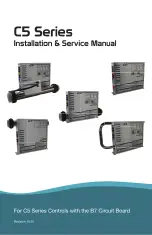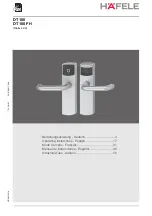
Micro-Master Touch User Guide
105
© 2014 Toro Australia Pty Ltd
Ver 1.2, June 2014
Pulses Per mm
Shows the pulses per mm calibration value for the Rain Bucket. Selecting the Pulses per mm button
and clicking Edit will display the Number Edit screen.
Rain Days
Shows the period rainfall will be logged for to calculate total rainfall. Selecting the Rain Days button
and clicking Edit will display the Number Edit screen.
Rain Cancel
Shows the rainfall level at which the Rain Switch be set and irrigation will be cancelled. Selecting the
Rain Cancel button and clicking Edit will display the Number Edit screen.
Allocated Input
Shows the input the rain sensor will monitor for precipitation pulses. Clicking on Allocated Input will
select the item, changing the background of the item to light blue. Selecting the Allocated Input and
then clicking Edit will display the Control Selection screen.
Total Rainfall
Shows the Total Rainfall accumulated over the last Rain Days period in hourly increments. Selecting
the Total button and clicking Clear will clear the Total Rainfall.
Rain Bucket Enabled
The Rain Bucket can be enabled or disabled. Clicking on the tick (cross) will set the sensor to
disabled (enabled).
14.8
Analogue Sensors
14.8.1 Overview and Operation
The Micro-Master Touch supports up to 160 independent analogue sensors. An analogue sensor can
be used as a flow meter, a general purpose measurement sensor or used as an input to Rules.
The analogue sensors measure the electrical current flowing through the sensor input. These types
of sensors are also known as current loop sensors.
A 4-20mA current loop is a communication interface that uses current instead of voltage for signaling.
Current loops can be used over moderately long distances (tens of kilometres). Analogue current
loops are used where a sensor device must be monitored remotely over a pair of conductors.
Each analogue sensor can be named and can be enabled or disabled.
Analogue Sensor Operation
When an analogue sensor is enabled, the analogue input current is monitored every second by each
analogue expansion module and the value of the analogue sensor is calculated. If the analogue
sensor detects the calculated analogue value is greater than the lower limit, the analogue meter is
active. If the calculated input value exceeds the adjustable trigger value, the analogue sensor is
triggered. When the calculated input value falls below the trigger value, the analogue sensor
becomes active, or untriggered. When the calculated input value falls below the lower limit, the
















































